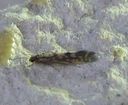Hydroptiloidea
Hydroptiloidea
Classification
- Phylum: Arthropoda
- Subphylum: Hexapoda
- Class: Insecta
- Order: Trichoptera
- Suborder: Integripalpia
- Superfamily: Hydroptiloidea
Pronunciation
How to pronounce Hydroptiloidea: /haɪdrɒptɪˈlɔɪdiə/
These audio files are automatically generated. While they are not always 100% accurate, they are a good starting point.
Images






Summary
Hydroptiloidea is a superfamily of caddisflies, containing the family Hydroptilidae, which are known for their small size and unique case-building behavior in larvae.
Physical Characteristics
Hydroptilidae are much smaller than other caddisflies, rarely exceeding 5 mm (0.20 in) in length. Their larvae do not build a protective case until the final instar, at which time they construct a typically purse-shaped case.
Identification Tips
Look for very small caddisflies, typically less than 5 mm long, and check for the distinctive purse-shaped larval case made during the final instar.
Habitat
Hydroptilidae larvae are found in freshwater environments, often associated with various aquatic habitats.
Distribution
Hydroptilidae have a worldwide distribution, with around 360 species described in about 23 genera in certain areas, and more than 90 genera worldwide.
Diet
The diet of Hydroptilidae larvae primarily consists of detritus and algae.
Life Cycle
Hydroptilidae undergo complete metamorphosis, with life stages including egg, larva, pupa, and adult. The larval stage is characterized by the construction of a protective case in the final instar.
Reproduction
Little detailed information is available on reproduction, but like other caddisflies, they likely lay eggs in or near water.
Ecosystem Role
Hydroptilidae play a role in aquatic ecosystems as both detritivores and as prey for other organisms.
Collecting Methods
- Light trapping
- Net sweeping
- Sediment sampling
Preservation Methods
- Drying
- Alcohol preservation
Evolution
Their systematic placement is debated, with traditional placements in the suborder Spicipalpia and contemporary studies favoring incertae sedis in Trichoptera.
Similar Taxa
Misconceptions
Hydroptilidae are often overlooked due to their small size and similarity to other caddisflies; some may confuse their larval cases with those of other taxa.
Tags
- Entomology
- Trichoptera
- Caddisflies
- Hydroptilidae